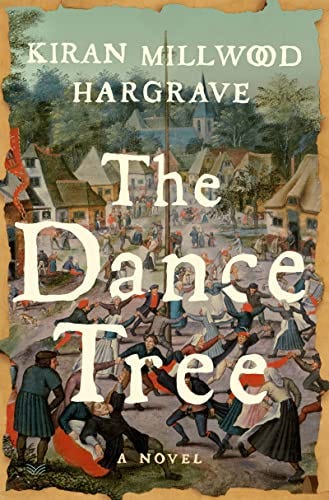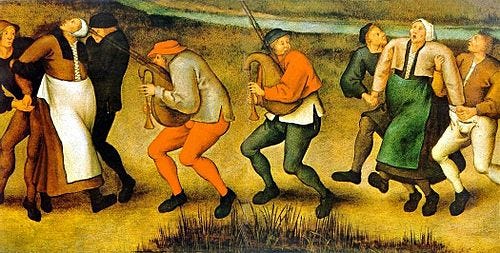The Dance Tree
Years ago, pre-Google, I came upon a strange phenomenon that I thought of as “dance fever”: groups of medieval women who danced in public squares and streets, sometimes dancing from one village to the next, ecstatic, collecting dancers along the way.
Right on! I thought. Who doesn’t love to dance?
The whole thing struck me as funny.
What I didn’t know was, many danced until their feet bled, until they fell from hunger and exhaustion—or dropped dead, ignored, perhaps not even noticed, by the dancers writhing around them. Variously labeled “dancing mania,” “dancing plague,” and “St. Vitus’ Dance,” outbreaks of wild, erratic dancing occurred throughout Europe between the fourteenth and sixteenth centuries, often in the aftermath of plague, famine, war, and natural disaster.
Nobody really knows why.
The speculations of modern scientists—mass psychogenic illness, collective mental disorder, Sydenham chorea, choreomania—would have made no sense to the dancers or to the all-powerful church and its brutal henchmen, who believed dancing mania was caused by the devil and should be punished accordingly.
Kiran Millgrove Hargrave’s novel The Dance Tree imagines the outbreak of dance mania that occurred in the summer of 1518, in Strasbourg. It begins with Frau Troffea, the woman known to have triggered the dancing, as she stumbles through the town, having heard there might be bread in the square. She is starving. “She has started chewing off-cuts of leather. She has started sucking the ends of her hair, and contemplating stray dogs with new attention. She has started seeing white lights hang before her in the air. Lately she can stir them about with her finger.”
She finds no bread when she gets to the square, no hope for anything to eat. So, she stands beneath the burning sun, “…lifts up her hands, and begins to dance.”
We don’t see Frau Troffea again. Her story is just the first in a series about women who join the dance, interspersed with the story of Lisbet, a woman in her seventh month of pregnancy who lives on a farm outside the town, where she is a beekeeper. Her husband Heinrich cares only for the son he expects her delivering; her mother-in-law Sophey is cold and disapproving. Lisbeth finds comfort only in the kindness of her friend Ida and in the secret shrine she made to her twelve miscarried babies deep in the forest, in the remains of a pagan dance tree once used celebrate the coming of spring.
Her story begins when Heinrich’s sister Nethe returns after seven years of penitence for a sin no one will name. The same day, Ida’s husband Plater, the town council’s cruel enforcer, brings Heinrich a summons to the papal court in Heidelberg to defend a claim to the family land by the monks of Aldorf.
Unrest in the town grows in Heinrich’s absence, fueled by hunger, disease, superstition, fear of infidels, and rumors of beatings and hangings at the hand of Plater’s men. Townswomen, farmwives, travelers join Frau Troffea’s dance, soon filling the town square. The town council hires musicians, hoping to soothe them into submission. Lisbet and Sophey must house two of them, young Turks fleeing the Ottoman war. Will Lisbet and Sophey be safe with them?
There are other questions. Why was Nethe sent away, what is the source of the terrible tension between her and Ida? Will Lisbet lose another baby under the strain of taking on Heinrich’s duties? How will the paths of Lisbet, Ida, Nethe, and Sophie intersect with the women dancing in the square?
I’ll leave you the pleasure of finding the answers to these questions and others that that appear and are answered along the way.
Like all well-researched historical fiction, The Dance Tree not only brings a past time to life but brings to mind parallels with our own.
Religion as a means of control over women’s bodies and lives, the church’s modern-day henchmen at the ready to punish those who don’t fall in line.
Hunger and poverty plaguing the less fortunate.
The supremacy of white men.
Hatred and persecution of “The Other”.
The ravages of nature.
The devastation of war.
According to Hilary Mantel, author of the critically acclaimed Wolf Hall trilogy about the rise and fall of Thomas Cromwell in the court of Henry VIII, writing historical fiction requires “an informed imagination.” The research for good historical fiction is comparable to research for good historical nonfiction, she says. The difference, of course, is permission to imagine what might have happened to people—famous or obscure—launching stories from bits of fact that lift and become absolutely real to the writer and the reader.
Kiran Millwood Hargrave disabused me of the idea that dance mania was funny. Reading The Dance Tree, I felt like one of those battered, hopeless dancers myself.
I totally get why those women walked away from their impossible lives, dropped their burdens, and danced. Why other suffering women with nothing to lose would join them—and more and more and more of them until they numbered in the hundreds. Ecstatic, broken, defiant. Willing to die for just one moment of power and freedom.
The book made me wonder why women aren’t doing it now.
#KiranMillwoodHargrave, #historicalfiction, #dancingmania, #HilaryMantel




Sounds wonderful! I had never heard of this writer before but it looks like she is also a poet xoxo
Of course you did! :-)